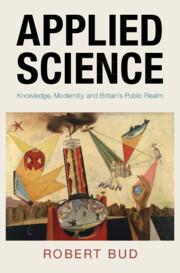Book contents
- Applied Science
- Science in History
- Applied Science
- Copyright page
- Dedication
- Contents
- Figures
- Acknowledgements
- Introduction
- Stage 1 Origins and Pedagogy in the Nineteenth Century
- Stage 2 Research in the Early Twentieth Century
- Stage 3 After World War Two
- 7 Co-existence through Growth
- 8 From Applied Science to Technological Innovation
- Conclusion
- Archives Used
- References
- Index
7 - Co-existence through Growth
from Stage 3 - After World War Two
Published online by Cambridge University Press: 15 March 2024
- Applied Science
- Science in History
- Applied Science
- Copyright page
- Dedication
- Contents
- Figures
- Acknowledgements
- Introduction
- Stage 1 Origins and Pedagogy in the Nineteenth Century
- Stage 2 Research in the Early Twentieth Century
- Stage 3 After World War Two
- 7 Co-existence through Growth
- 8 From Applied Science to Technological Innovation
- Conclusion
- Archives Used
- References
- Index
Summary
This chapter addresses the post–World War Two reshaping of models of applied science and technology coexisting in education, research policy, and the management of innovation. The shortage of skilled personnel highlighted the questions of training and secrecy and the boundary between applied science and technology. In the years after World War Two, the United States held a hegemonic scientific and cultural place, which meant that its language and issues came to be influential across the Atlantic. However, British authorities, steeped in domestic experience and tradition, reconstituted as they ingested, and Bush’s Science – The Endless Frontier was read differently in London than in Washington, DC. The case study of the UK Atomic Energy Authority (UKAEA) highlights institutional tensions between those identifying with technology and those identifying with applied science, but also highlights how sharply rising investment in research sustained a variety of models of the knowledge required for industrial development, and temporarily eased their coexistence.
Keywords
- Type
- Chapter
- Information
- Applied ScienceKnowledge, Modernity, and Britain's Public Realm, pp. 195 - 225Publisher: Cambridge University PressPrint publication year: 2024



